Biotech giant shelves old, cold method of picking orders
This November marks 10 years that Thermo Fisher Scientific has been manufacturing, storing and delivering essential consumables to life-science researchers worldwide. Workers at Thermo Fisher’s global manufacturing and distribution center in Frederick, MD, fill orders by picking from thousands of unique stock keeping units (SKUs), including many products that must be preserved in a cooler or freezer.

In 2012, Thermo Fisher Scientific installed about 1,600 linear feet of Span-Track wheel-bed shelving on pallet racks inside a cold box and freezer to improve workers’ pick efficiency. Photo courtesy UNEX Manufacturing Inc.
In 2012, engineers at the center realized they needed to dramatically improve pick efficiencies in the 13,000-square-foot cold box and 9,000-square-foot freezer to keep up with customer demand. At the time, about 35 pickers worked inside both areas and wore cold suits because of the extreme temperatures. More importantly, they picked items from three to 10 boxes, each of which held products with different SKUs.

Span-Track shelving efficiently displays bins containing 2,000 temperature-sensitive SKUs. Photo courtesy UNEX Manufacturing Inc.
“Pickers had to go through all the boxes on a pallet to find the right SKU, which was quite time consuming,” says Thomas Brown, systems engineer at TFS. “We needed a way to pick more efficiently and accurately to get products out the door faster.”
Brown and his team decided to redesign both areas to optimize carton flow and order picking. Step one of the redesign involved installing 94 glass doors, which are similar to those used in grocery store freezers and convenience stores. The company also installed about 1,600 linear feet of UNEX’s Span-Track wheel-bed shelving on pallet racks inside the enclosed areas.
The racks are positioned immediately behind each door, so workers can see what’s on the shelves without having to open the door or walk into the storage area. The shelves are tilted slightly to allow easy access, and they are segmented to hold bins of various sizes. To pick a SKU, a worker simply opens a door and reaches into a bin.
According to Bill Costa, vice president of sales at Werres, a distributor for UNEX Manufacturing Inc., the shelving efficiently stores enough bins for 2,000 temperature-sensitive SKUs. Costa says this amount of SKUs represents 70 percent of the workers’ daily picks.
“We chose Span-Track because [it] provides maximum flexibility for slotting SKUs of different sizes—from vials that may be an inch high to 10-milliliter bottles,” explains Brown. “Now, we can get 20 to 30 bins of SKUs on four to five levels of [shelving].”
The condensed and organized storage areas enable pickers to more clearly see the SKUs. As a result, picking errors have decreased dramatically. It also has improved pick efficiency by more than 45 percent, so workers spend considerably less time replenishing SKUs.
Brown also points out that, since the redesign, pickers have a safer and more comfortable work environment. They no longer have to climb up and down ladders, or work around forklifts and push carts to pick SKUs.
Another benefit of the redesign is cost savings. Fewer pickers are needed at the plant because of productivity improvements, and shifts at the plant have been reduced from 12 to 8 hours.
“Span-Track was just one piece of a huge transformation for the plant,” explains Brown. “But it was the piece that brought everything together.”
“Because Thermo Fisher is known for its innovative solutions, the Maryland plant must have built-in flexibility to accommodate the company’s ever-growing product mix,” concludes Costa. “Span-Track offers that flexibility.”



